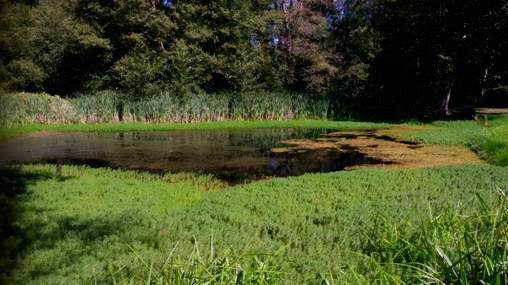A storm water retention pond in Langley found to have petroleum and barium contaminants in the sediment was recently pumped of its water.
Some concern arose over the pond’s high water level and that it was not flowing properly. That appears to be true, Mayor Fred McCarthy said, as a contracted crew familiar with retention pond work was unable to find an outfall pipe after pumping out about 100,000 gallons.
“That was quite a bit of water draining the pond,” McCarthy said.
The city’s public works director, Stan Berryman, said the water was pumped into Brookhaven Creek, which drains into Saratoga Passage at Seawall Park. So far, the work has cost the city about $3,000, and Berryman said the cost of removing invasive vegetation choking the pond will likely be greater but he did not have any estimates at the time.
The pond is located near Suzanne Court and is one of the main retention facilities to treat runoff from the city’s streets. As water flows down roads and into storm water pipes, it collects at a retention pond where the flow slows, allowing heavier sediment and contaminants, such as fuel and heavy metals from vehicle brakes and fluids, to collect rather than continue out to Puget Sound.
“The way it’s operating right now it’s satisfactory,” McCarthy said.
But the city knows it needs to have a plan to take out the contaminated dirt at some point.
The issue came to a head earlier this summer when the city’s public works department was informed that Island County Solid Waste was unable to handle the volume of the soupy sediment. In earlier interviews, county staff with the waste department said they did not have a facility large enough to dry out the wet soil to decrease its weight and overall cost for disposal.
“It hasn’t been cleaned out in at least 20 years,” Berryman said.
That left Langley with dirty soil, a retention pond in need of dredging but nowhere to dry out the mud and vegetation. Pumping the water helped dry out some of the plants and soil, allowing Pioneer Tree Services of Oak Harbor to search for the outfall, which was not located.
“It looks like it may be the only channel,” Berryman said of the current outfall into Brookhaven Creek. The other outfall, he said, would likely connect to a watershed basin that eventually connects with the creek.
McCarthy said the city is now trying to find out what it can do with the pond if there is no outfall pipe.
The contaminated soil is a long-term concern, said McCarthy, but he pointed out that trapping pollutants from runoff is one of the functions of a retention pond.
“It’s no different than any other retention pond, that’s what they’re designed to do,” he said.



